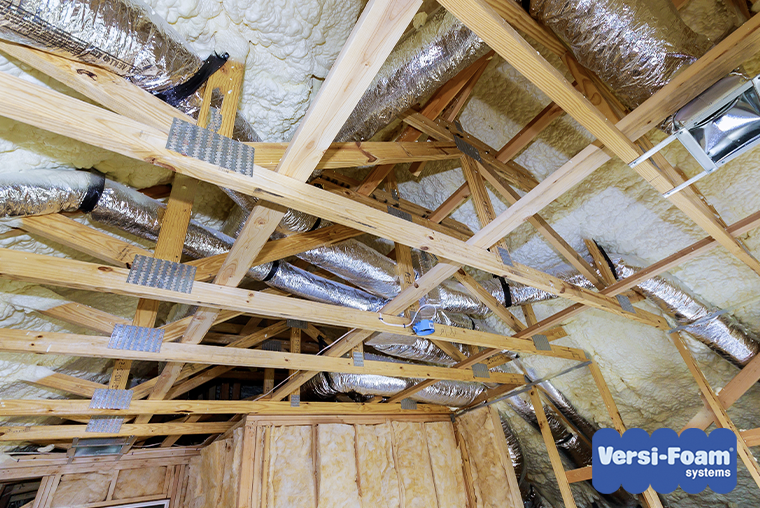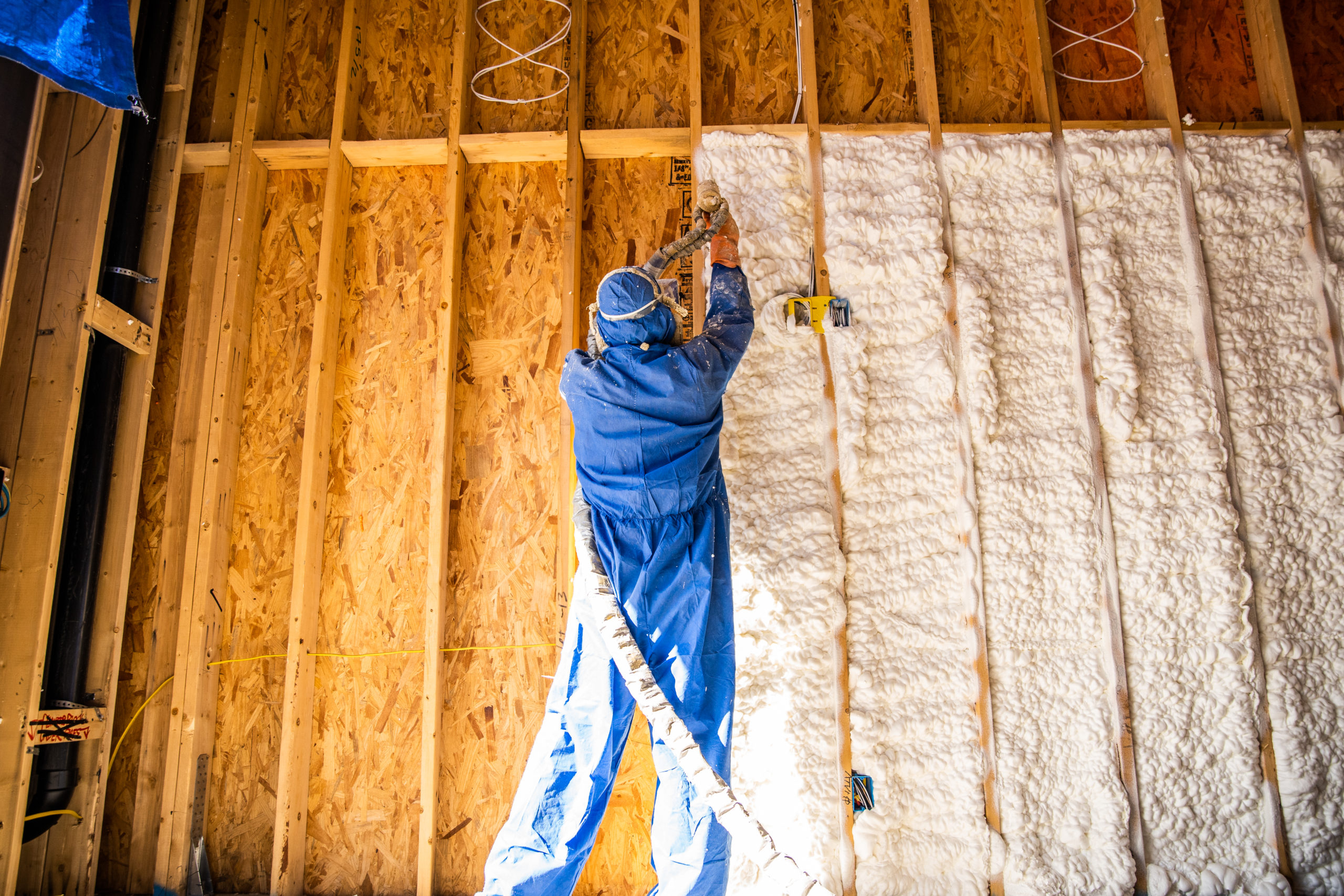The Environmental Impact of Spray Foam: Sustainability Factors To Consider
The Environmental Impact of Spray Foam: Sustainability Factors To Consider
Blog Article
Spray Foam: The Ultimate Service for Air Sealing and Insulation
Spray foam insulation has actually emerged as a leading solution for reliable air securing and thermal insulation, supplying a distinct combination of residential or commercial properties that establish it apart from typical methods. Its capacity to increase and load spaces makes it specifically reliable in protecting against air leak, which can dramatically affect energy effectiveness. Nevertheless, comprehending the full extent of its advantages, setup processes, and comparisons with various other insulation kinds is important for making informed choices. As we discover these facets, the ramifications for both new buildings and retrofits end up being increasingly considerable. What elements should affect your selection?
What Is Spray Foam?
Spray foam is a flexible insulation material that combines the concepts of air securing and thermal resistance to enhance power efficiency in structures. Composed mainly of polyurethane or other similar compounds, spray foam is applied as a fluid that increases upon call with surfaces, creating a strong, continuous layer of insulation. This one-of-a-kind residential property enables it to fill up gaps, splits, and voids that standard insulation products might forget, supplying a remarkable air seal.
There are two main sorts of spray foam: open-cell and closed-cell. Open-cell spray foam is lighter and a lot more versatile, providing exceptional audio absorption and a lower R-value per inch - Spray Foam. On the other hand, closed-cell spray foam is denser, offering a greater R-value, moisture resistance, and added architectural integrity to building parts
The application procedure generally entails specialized equipment, making sure a smooth application that sticks to numerous substrates, consisting of metal, concrete, and timber. This adaptability makes spray foam appropriate for both new constructions and retrofitting existing structures. Its capacity to develop an airtight barrier significantly contributes to reducing power usage and boosting interior air quality, thereby making it a favored option amongst builders and house owners alike.
Benefits of Spray Foam Insulation
One of the most considerable advantages of spray foam insulation is its extraordinary ability to develop a constant air barrier, which successfully minimizes power loss. Unlike typical insulation materials, spray foam expands to load splits and voids, ensuring that air leak is considerably minimized. This characteristic not only improves energy effectiveness but likewise leads to reduce energy expenses with time.
Additionally, spray foam insulation provides superior thermal resistance, adding to a much more stable interior atmosphere. Its high R-value per inch permits for reliable insulation in confined areas, making it suitable for attics, walls, and crawl areas. Additionally, the moisture-resistant properties of spray foam aid protect against mold and mildew and mildew growth, advertising much healthier living conditions.
An additional essential advantage of spray foam insulation is its sound-dampening top qualities (Spray Foam). It efficiently reduces noise transmission between rooms, producing a quieter and much more comfy home environment. The toughness of spray foam also stands apart, as it does not droop or settle with time, maintaining its performance throughout its lifespan
Just How Spray Foam Functions
Recognizing how spray foam insulation works is vital for valuing its effectiveness in air sealing and thermal resistance. Spray foam insulation includes 2 main elements: isocyanate and polyol material. When these components are combined, they undertake a chemical reaction that causes the product to expand swiftly, creating a dense foam that loads spaces, splits, and cavities.
As the foam expands, it follows surface areas, creating an airtight seal that considerably lowers air infiltration. This particular makes More hints spray foam insulation highly reliable at stopping drafts and wetness penetration, which can result in energy loss and damage gradually. Additionally, the closed-cell version of spray foam offers premium thermal resistance due to its rigid structure, properly lessening warm transfer.
The unique buildings of spray foam allow it to adapt uneven surfaces, making certain extensive insurance coverage and a smooth obstacle. Therefore, spray foam insulation not just enhances energy efficiency but likewise adds to improved interior air high quality by reducing the build-up of contaminants and irritants. Inevitably, understanding the auto mechanics behind spray foam emphasizes its function as a superior option for insulation and air securing in both commercial and residential applications.
Installment Refine Summary

Prior to installation, the room needs to be effectively cleansed and prepped, making sure that surface areas are without dust, wetness, and debris. Since contaminants can compromise attachment and total efficiency, this step is vital. Once the area is prepared, the application includes blending both parts of the spray foam, which broadens upon call and fills spaces successfully.
Educated experts must carry out the installment, using specific devices to ensure consistent protection and optimal thickness. Safety and security precautions, including wearing safety equipment and ensuring appropriate ventilation, are crucial throughout this procedure. After application, the foam generally cures swiftly, developing a solid obstacle that boosts energy effectiveness.
Comparing Spray Foam to Traditional Insulation
When evaluating insulation choices, spray foam insulation sticks out in comparison to standard materials such as fiberglass and cellulose. One of the primary advantages of spray foam is its exceptional air securing capacities. Unlike fiberglass and cellulose, which can permit air seepage, spray foam increases upon application, official site filling up gaps and gaps to create an impermeable seal. This causes improved power performance, as less heated or cooled down air escapes the home, causing reduced utility expenses.
Furthermore, spray foam gives a higher R-value per inch than typical insulation kinds, providing even more efficient thermal resistance in a thinner profile. This particular is specifically useful in spaces with minimal dental caries depth. Additionally, spray foam is immune to wetness and mold growth, which can be a significant interest in cellulose and fiberglass, particularly in damp settings.
However, spray foam insulation commonly lugs a greater in advance expense than its traditional counterparts. Property owners must weigh this preliminary financial investment against long-lasting power savings and efficiency advantages. Ultimately, while both insulation kinds serve their purpose, spray foam emerges as a more innovative service for modern-day insulation needs, specifically in terms of air securing and thermal efficiency.

Verdict
In recap, spray foam insulation represents an extremely effective option for achieving optimum air sealing and thermal resistance. Its one-of-a-kind properties, consisting of wetness resistance and audio dampening, make it suitable for various applications in both brand-new constructions and retrofitting jobs (Spray Foam). Although the initial prices might be greater contrasted to you can look here standard insulation materials, the long-term benefits, such as considerable power cost savings and enhanced interior air top quality, justify the investment and underscore its worth in contemporary building techniques.
Spray foam insulation has arised as a leading option for effective air sealing and thermal insulation, providing an one-of-a-kind mix of buildings that set it apart from typical techniques.Spray foam is a functional insulation material that combines the principles of air securing and thermal resistance to improve energy efficiency in buildings.When assessing insulation alternatives, spray foam insulation stands out in contrast to standard products such as fiberglass and cellulose. Inevitably, while both insulation kinds serve their objective, spray foam emerges as a more innovative solution for modern-day insulation requirements, specifically in terms of air sealing and thermal performance.
In recap, spray foam insulation represents a very reliable option for attaining optimal air securing and thermal resistance.
Report this page